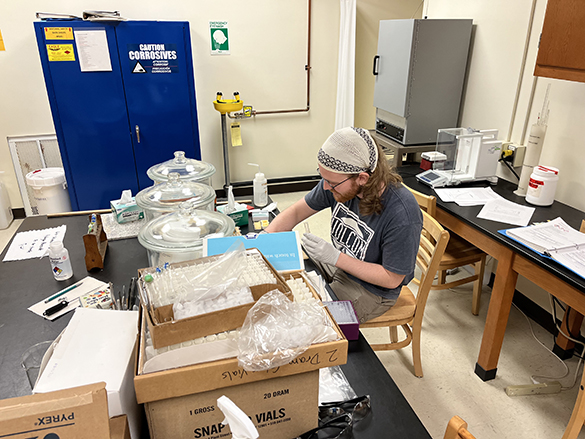 Editor’s Note: Independent Study (IS) at The College of Wooster is a three-course series required of every student before graduation. Earth Sciences students typically begin in the second semester of their junior years with project identification, literature review, and a thesis essentially setting out the hypotheses and parameters of the work. Most students do fieldwork or lab work to collect data, and then spend their senior years finishing extensive Senior I.S. theses. The following is Garrett’s thesis abstract —
Editor’s Note: Independent Study (IS) at The College of Wooster is a three-course series required of every student before graduation. Earth Sciences students typically begin in the second semester of their junior years with project identification, literature review, and a thesis essentially setting out the hypotheses and parameters of the work. Most students do fieldwork or lab work to collect data, and then spend their senior years finishing extensive Senior I.S. theses. The following is Garrett’s thesis abstract —
The BLGR – 01 core, a 1.5-meter sediment core from a kettle lake near Shreve, Ohio, and dated with 210Pb, and 14C records changes in climate, ecology, and sedimentation from the last 2,000 years of the Holocene. Siliceous freshwater sponge spicules and diatom frustule microfossils from the BLGR – 01 core were collected and analyzed to measure population dynamics through time as well as to infer ecological changes in the lake. Our hypothesis that sponge and diatom data would supplement one another was not supported, as sponge data was not of a high enough resolution; but both proxies revealed changes unrelated to one another.
Using the wet oxidation method, 3 genera of freshwater sponge (Racekilea, Heteromeyenia, Anheteromeyenia) and two individual species were identified based on spicule morphology via light microscopy. Sponge biostratigraphy results display a sustained community prior to local deforestation, followed by an abrupt disappearance in silty intervals, concluding with a reemergence 20 years ago. One sponge genus remains locally extinct in Brown’s Lake.
Seventeen diatom genera were recorded, and the eight most prominent (Eunotia, Tabellaria, Cyclotella, Lindavia, Discostella, Gomphonema, Stauroneis, Navicula) were counted at 5cm intervals on smear slides. Spikes and dips in diatom populations suggest periods of warming and cooling that affected these organisms. Radiocarbon dating confirmed the presence of peat that accumulated during the Late Antique Little Ice Age, which was corroborated by the low numbers of diatom frustules in the bottom 30cm of the core.


